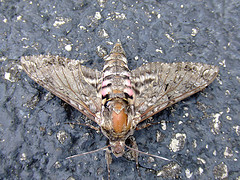Moths are an insect of the Lepidoptera order and there are thought to be 150,000 to 250,000 different species. They come from caterpillars who have spun cocoons form silk fibre. When the caterpillars have completely developed in the cocoon, they hatch out as fully grown moths. For the best chance of survival, caterpillars spin these cocoons in places that are out of sight of predators. This can be in treetops or dug into the ground. Whether anything has a purpose or not is something that can widely debated. As far as moths are concerned, there are some species that do have benefits for humans.
The silkworm, the larva of the moth Bombyx mori, is farmed extensively for the silk with which it builds its cocoon. Using this the silk industry produces over 130 million kilograms of raw silk each year. This has a monetary value of about $250 million. Not all of the silk is produced by this particular moth. There are other species such as the Saturniidae, Ailanthus moth, Chinese Oak Silk Moth, the Assam Silk Moth and the Japanese Silk Moth, that are also farmed for this material. The mopane worm, the caterpillar of the Gonimbrasia belina moth, also has a beneficial role as a significant food resource in southern Africa.
Most argue that other species of moths are a major agricultural pest. The caterpillar of the Gypsy Moth has caused severe damage to forests in the northeast United States which the codling moth has caused extensive damage to fruit farms in temperate climates. In tropical and subtropical climates, the diamondback moth is known to seriously damage brassicaceous crops. The moth family of Tineidae are not pests in an agricultural sense but instead do damage by eating fabric such as clothes and blankets made from natural fibres like wool or silk.
The silkworm, the larva of the moth Bombyx mori, is farmed extensively for the silk with which it builds its cocoon. Using this the silk industry produces over 130 million kilograms of raw silk each year. This has a monetary value of about $250 million. Not all of the silk is produced by this particular moth. There are other species such as the Saturniidae, Ailanthus moth, Chinese Oak Silk Moth, the Assam Silk Moth and the Japanese Silk Moth, that are also farmed for this material. The mopane worm, the caterpillar of the Gonimbrasia belina moth, also has a beneficial role as a significant food resource in southern Africa.
Most argue that other species of moths are a major agricultural pest. The caterpillar of the Gypsy Moth has caused severe damage to forests in the northeast United States which the codling moth has caused extensive damage to fruit farms in temperate climates. In tropical and subtropical climates, the diamondback moth is known to seriously damage brassicaceous crops. The moth family of Tineidae are not pests in an agricultural sense but instead do damage by eating fabric such as clothes and blankets made from natural fibres like wool or silk.

